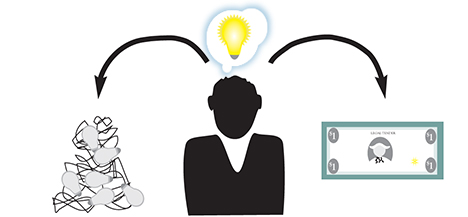 "I have a great idea,” said my friend, calling me to tell
me about the latest sure thing he had dreamt up. Because I run a marketing
company, I have taken similar calls. Over the years, whenever I hear those
words, my mind bounces between two thoughts: maybe they are on to something, or
maybe they are headed for a whole lot of nothing. All great inventions started
with a dream that someone pursued, even when others disparaged the idea. On the
other hand, many more ideas fail than make it to market. What is the
difference?
"I have a great idea,” said my friend, calling me to tell
me about the latest sure thing he had dreamt up. Because I run a marketing
company, I have taken similar calls. Over the years, whenever I hear those
words, my mind bounces between two thoughts: maybe they are on to something, or
maybe they are headed for a whole lot of nothing. All great inventions started
with a dream that someone pursued, even when others disparaged the idea. On the
other hand, many more ideas fail than make it to market. What is the
difference?
There are several explanations why a new idea never gains
traction and fails to make it from an idea to a hot seller in the marketplace.
However, many times the difference between success and failure lies with
marketing. The key difference that causes great ideas to fail is a lack of
planning and marketing – the two go hand-in-hand – before the product or
service is launched. Building a strategic marketing plan before you start
selling anything is crucial. If you try to skip ahead without a plan, your idea
will likely end up on the trash heap of ideas that never made it to the cash
register. Here are a few common reasons for failure based on pre-launch
marketing.
There
is not enough difference between the new product or service and what is already
established in the market.
Before you take any product or service to market, you must
do some homework for marketing to be effective. It starts with an analysis of
your brand. In a nutshell, you need to understand your strengths and
weaknesses. You may be a company of one or you may have hundreds of employees.
It doesn’t matter how small or large you are, you need to do an internal
analysis of your brand. Also, you need an evaluation of your competition. Who
else is selling a brand similar to yours? What are the differences? When you
compare your brand to your competition, do those differences put you in a
better or worse position in the marketplace? If you are in a good position,
wonderful! Plan to move ahead to the next step. If not, you have some work to
do before you are ready to go to market.
There
is a lack of understanding and definition of who will buy your brand and who
will not.
Analyze the consumers who make up the marketplace. What do
they want? How does your product or service help them? Does it exponentially
help some more than others? This will help you define a target market – those
who are likely to want or need what you are selling. It is then crucial to
figure out what mediums and what messaging your target market will tune in to
hear. Their desires define your marketing path forward.
There
are no goals; if there are, there is no plan to achieve them.
One more big mistake many dreamers make is this: a lot of
new products fail because there are no goals in place. Marketing works well
when there is a goal to achieve. Without a goal, you have no idea whether you
are being successful or not. Good marketing measures success and failure.
Before you launch, you need to determine where those lines of success are going
to lie. That may be the number of sales based on a campaign. However, I would
encourage you to break down the steps from the launch of your product to the
sale of it. For instance, how many people are actually looking at your
marketing compared to how many of them show interest in knowing more about your
brand? How many require follow-up marketing before they buy it for the first
time? Of those who bought, how many did you retain and make another sale? All
of these smaller goals will help you measure just how successful you are.
If you have a great idea that you think can’t miss, do
yourself a favor and take the time to do some pre-launch marketing. Make sure
you have a plan in place that sets goals and measures your marketing movement
towards achieving those goals. It is the difference between success and failure.